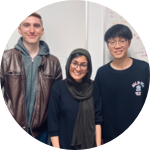About This Project
Towards reducing manufacturing costs for meat alternatives while increasing their palatability, we aim to produce a panel of ~100 engineered yeast strains with unique flavors. They will be dehydratable and self-replicating to be consumed as standalone foods or as additives to established nutritious substrates. Scientifically, this work will illuminate how only a few taste receptors can activate perception of many different flavors.
Ask the Scientists
Join The DiscussionWhat is the context of this research?
Raising animals for food produces ~15% of annual global greenhouse gas emissions. We need nutritious meat alternatives with minimal manufacturing, storage, and shipping costs. However, state-of-the-art solutions for low-cost and long-shelf-life meat alternatives lack variety and flavor, and each component has unique manufacturing requirements. Further, many alternative meat products contain water, which adds to their weight and complicates packaging. To improve on bland meat alternatives with complex components while boosting nutritional value, we propose a pipeline for building versatile, palatable yeast-based foods. Yeast can be eaten raw or cooked, and 1.5 tablespoons has 60 calories (0.5 g fat, 30 mg sodium, 3 g fiber, 8 g protein with all essential amino acids).
What is the significance of this project?
We will engineer nutritional yeast – a single-celled, dehydratable food – to incorporate designed proteins on its surface that will activate human taste receptors. When added in combinations, these engineered yeasts will expand the flavor profile of nutrient-dense substrates, evoking feelings linked with eating familiar foods. Our technology will improve the palatability and accessibility of meat alternatives by expanding the flavors and nutrients that can be incorporated in non-meat foods, while decreasing their cost, weight, and complexity. Scientifically, developing a panel of targeted taste receptor-binding proteins will also advance our knowledge of sensory perception and provide molecular tools to interrogate combinatorial receptor activation, which remains poorly understood.
What are the goals of the project?
We will produce a panel of hundreds of engineered yeasts with a variety of flavor profiles. We will first computationally design taste receptor-binding proteins, screen the designed proteins with yeast surface display, and characterize binders using in vitro techniques and receptor activation assays in human cell culture. The pipeline will be grounded in established yeast display methods and is thus easily transferable and adaptable. If our project is fruitful, we will then determine why different yeast strains evoke different taste perceptions. The first set of engineered yeasts can be transitioned to a commercial partner for industrial development as standalone yeast-based foods, or as additives to established food substrates like dried meat or vegetables, rice, tempeh, tofu, or seitan.
Budget
I think this project is going to work but is unlikely to be funded by NIH or other government agencies. I am hoping that with the preliminary data, we can bring in other funding, maybe from industry partners. I budgeted $50,000 here for project costs as we start working on it. I anticipate that the funds for supplies will cover the costs of the project, but that I will support my team using other funds (startup funds, eventually grants).
 Project Timeline
Project Timeline
Y1-1.5: Engineering yeast-tethered proteins that bind T1Rs
1.1. Pipeline testing and completion (0.75 yr)
1.2. Library generation (0.35 yr)
1.3. Screening and selection of designs (0.65 yr)
Y1.5-2: Biophysical/functional characterization of T1R-binding proteins
2.1. Establishing biophysical and functional assays (0.15 yr)
2.2. Compiling a full biophysical/functional dataset for hits in the library (0.25 yr)
2.3. Finding protein features that contribute to successful T1R binders (0.25 yr)
Jun 01, 2024
Development of an engineering pipeline to produce T1R-binding proteins.
Dec 31, 2024
Determine “functional hits” that activate intracellular Ca2+ release, protein features underlying this behavior, and their robustness to pH and temperature conditions.
Meet the Team
Team Bio
All three of us will collaborate on all aspects of the project, meeting weekly and ad hoc. This fast-paced project style of constant data review, troubleshooting, and planning is productive for us. Our lab is relatively young (began 1/1/2022), and the three of us started here together. Though our group has now grown to 10 people, Kyle and Chenlin helped to set a highly collaborative and fun scientific culture in which everyone shares their expertise.
Team Yeast Feast
PI: Dr. Anum Glasgow, assistant professor. I started my group in 1/2022. Recently, I designed the first de novo ligand binding site in a protein-protein interface to build chemically inducible sense/response systems; determined the allosteric mechanism of a classic transcription factor; and developed potent, mutation-robust therapeutics to treat SARS-CoV-2 infections. In our research group, we study the evolution of allosteric signal transduction in protein families, develop therapeutics, and build new technologies and software for high-throughput predictions of mutation-driven conformational changes in proteins.
Scientist: Kyle Weber, graduate student. Expertise: protein design, bioinformatics. Kyle joined our group as a technician in 1/2022 and is now as a 2nd-year graduate student. He grew up watching citrus trees in rural Florida die from a disease called citrus greening, which motivates his work in protein engineering for environmental applications. Here, Kyle has spearheaded the development of a new biotherapeutic format. Kyle and Chenlin are now computationally redesigning transcription factors as allosteric sensors and regulators to link continuous plastic degradation in continuous microbial culture to the production of value-added chemicals for plastic upcycling. They use a yeast surface display assay to screen their computationally designed sensors.
Scientist: Dr. Chenlin Lu, postdoctoral fellow. Expertise: MD simulations, allostery. Chenlin finished his Ph.D. at Tsinghua University 1.5 years ago, where he studied enzymatic molecular recognition, before joining us as a postdoctoral fellow. Chenlin is an expert in molecular dynamics (MD) simulations and has developed new methods to combine these with experimental hydrogen-deuterium exchange / mass spectrometry data to understand residue-resolved changes in free energy associated with ligand-induced conformational changes in transcription factors, which guide our computational protein design strategies.
Project Backers
- 0Backers
- 100%Funded
- $50,000Total Donations
- $0Average Donation
